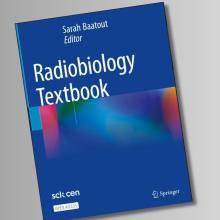Radiobiology textbook

Aimed at a wide audience, this guide is positioned as an essential learning resource, providing a solid foundation for students, scientists and medical staff interested in radiobiology. As a teaching tool, it is accompanied by educational material designed to facilitate understanding of the complex concepts involved in this constantly evolving discipline.
Through its 12 chapters, this handbook aims to cover the sub-disciplines involved in radiobiology such as radiophysics, radiation oncology, radiotherapy, radiochemistry, radiopharmacy, nuclear medicine, space radiation biology and physics, environmental and human radiation protection, nuclear emergency planning, molecular biology, bioinformatics, as well as the ethical, legal and social considerations related to radiobiology. The chapters in this handbook are designed to be entirely independent of each other and can therefore be read in any order.
- Chapter 1 describes the discovery of X-rays in 1895 by Wilhelm Röntgen and of radioactivity by Pierre and Marie Curie shortly afterwards. It details the first observations of the effects of radiation, which led to the development of radiotherapy.
- Chapter 2 familiarises the reader with the fundamental and important concepts of radiobiology, the use of radioactivity and its applications, the different types of interaction of radiation with living tissue and the possible effects of this exposure.
- Chapter 3 deals with the molecular biology of radiation and reviews the types of radiation-induced lesions in DNA, the types of DNA damage repair pathways and the importance of chromatin architecture in DNA damage and repair. IRSN was involved in writing this chapter with the participation of Sandrine Frelon from LECO and Olivier Guipaud and Agnès François from LRMed.
- Chapter 4 explains the principles of radiation dosimetry and discusses the importance of microdosimetry. This chapter presents the relationship between target theory and dose-response models. IRSN was involved in writing this chapter with the participation of Carmen Villagrasa and Yann Perrot from LDRI.
- Chapter 5 is devoted to the principles of radiotherapy of tumours, the therapeutic window and therapeutic ratio, tumour growth and control, and the 6Rs concept. The chapter concludes with sections on normal tissue lesions, response to radiotherapy, and the importance of stem cells and microbiota in radiotherapy. IRSN was involved in writing this chapter, with contributions from Olivier Guipaud, Fabien Milliat, Agnès François, Alexendra Semont and Mallia Geiger of LRMed.
- Chapter 6 reviews the various conventional and alternative irradiation regimens and analyses the different modalities of radiotherapy in combination with other cancer treatments. Specific sections are devoted to brachytherapy, radionuclide therapy and charged particle therapy.
- Chapter 7 deals with individual radiosensitivity and biomarkers. It examines the variation in radiosensitivity as a function of age, biological sex and genetic syndromes. The chapter concludes with a perspective on personalised medicine.
- Chapter 8 covers accidental, public and occupational exposures, reviewing the different radiation exposure scenarios, the long-term health effects of low doses of radiation in exposed human populations, and the problem posed by radon.
- Chapter 9 provides an overview of the behaviour and fate of radioelements in the environment. It then examines the impact of ionising radiation on non-human biota and looks at the specific case of contamination by radioactive materials of natural origin.
- Chapter 10 looks at the history of space radiation studies and the impact of space travel on human health. It presents the different models (animals, plants, small organisms, micro-organisms) sent into space and the biological changes induced by space radiation.
- Chapter 11 reviews radioprotectors, radiomitigators and radiosensitisers, as well as internal contamination by radionuclides and possible treatments. It provides a comprehensive overview of the molecules and mechanisms involved in the biological effects of ionising radiation and discusses their potential clinical use in radiotherapy or in radiation protection following accidental radiation exposure and/or nuclear emergencies.
- Finally, Chapter 12 explores the ethical, social, epistemological and legal considerations relating to radiobiology. The chapter provides an overview of the basic principles relating to each aspect, while discussing contentious issues and potential future developments, as well as more in-depth analyses where appropriate.
